Solanum polyadenium
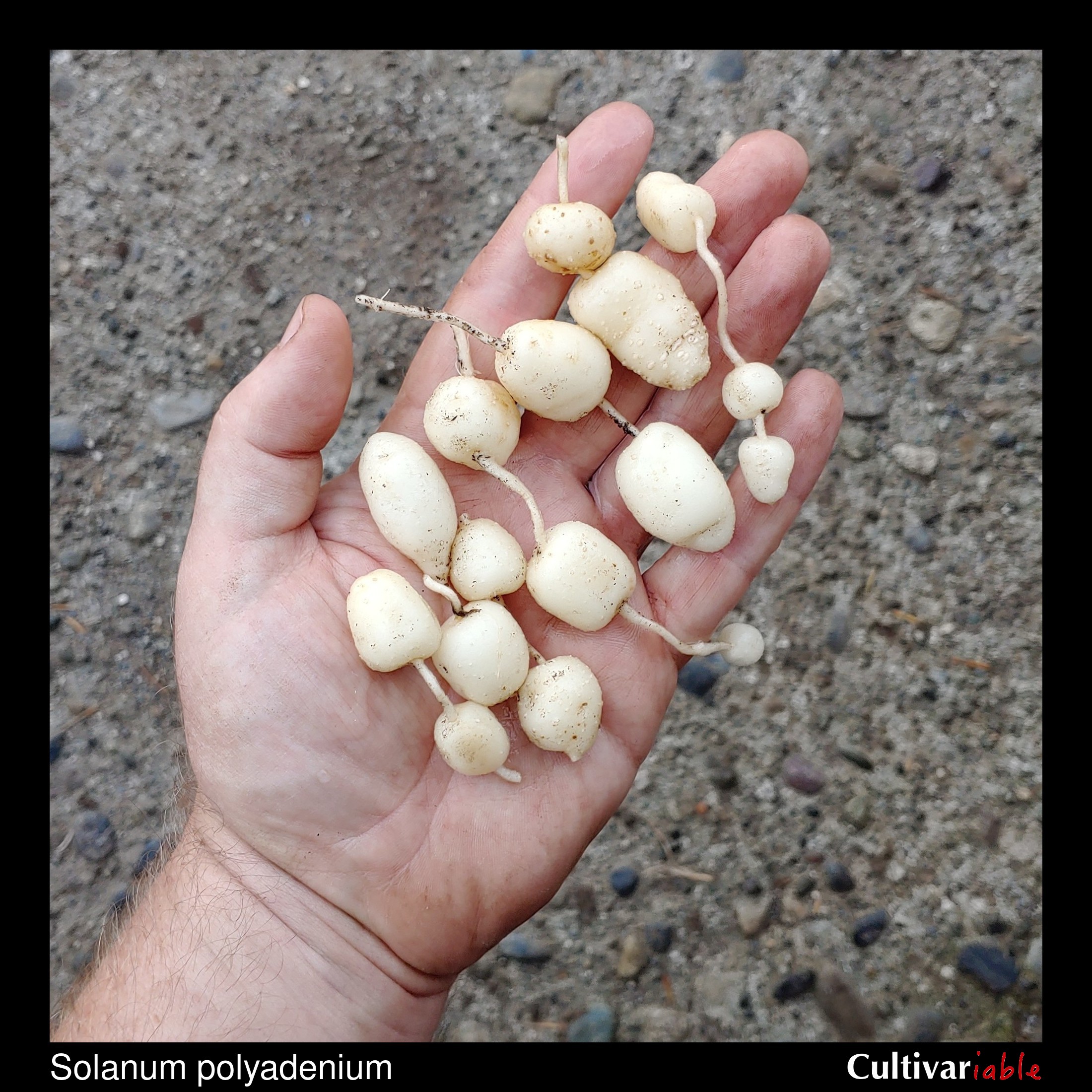
| Common Names | |
| Code | pld |
| Synonyms | |
| Clade | 1 |
| Series | Polyadenia |
| Ploidy | Diploid (2x) |
| EBN | 2 |
| Tuberization Photoperiod | Unknown |
| Self-compatibility | Yes |
| Nuclear Genome | B |
| Cytoplasmic Genome | W |
| Citation | Greenman: Proc. Amer. Acad. Arts 39: 89. 1903. |
Description
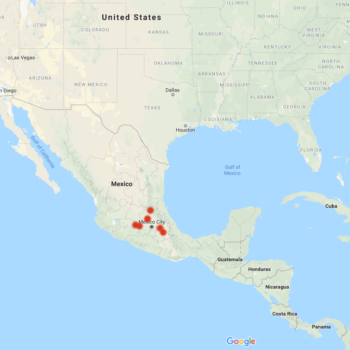 Solanum polyadenium is a widespread, woodland species in central Mexico. Plants range from about a foot to 4.5 feet tall. Leaves are densely covered in glandular hairs. White flowers. Round fruits. Tubers narrow and sometimes coiling but can grow more than a foot long, the largest of any wild species according to Correll (1962).
Solanum polyadenium is a widespread, woodland species in central Mexico. Plants range from about a foot to 4.5 feet tall. Leaves are densely covered in glandular hairs. White flowers. Round fruits. Tubers narrow and sometimes coiling but can grow more than a foot long, the largest of any wild species according to Correll (1962).
The specific epithet, polyadenium, means “many glands,” referring to the glandular hairs of this species. It is formed from the Greek words “polys,” for “many,” and “aden,” for “gland.” While there is no completely standardized pronunciation for scientific names, the most common way to pronounce this species is probably so-LAY-num pol-ee-uh-DEE-nee-um.
Growing at 6,200 to 9,500 feet (1900 to 2900 m) on limestone and volcanic soils (Correll 1962).
Resistances
This species can survive frosts down to 26 degrees F (-3.5 C) (Li 1977). Vega (1995) found that this species is less frost tolerant than domesticated potato.
Pelletier (1999) found that Colorado potato beetles have increased adult and larval mortality and low egg production on this species.
| Condition | Type | Level of Resistance | Source |
|---|---|---|---|
| Alternaria solani (Early Blight) | Fungus | Somewhat resistant | Jansky 2008 |
| Drought | Abiotic | Somewhat resistant | Machida-Hirano 2015 |
| Frost | Abiotic | Somewhat resistant | Machida-Hirano 2015 |
| Globodera pallida (Pale Cyst Nematode) | Invertebrate | Not resistant | Bachmann-Pfabe 2019 |
| Globodera rostochiensis (Potato Cyst/Golden Nematode) | Invertebrate | Somewhat resistant | Machida-Hirano 2015 |
| Heat | Abiotic | Somewhat resistant | Machida-Hirano 2015 |
| Leptinotarsa decemlineata (Colorado Potato Beetle) | Invertebrate | Somewhat resistant | Machida-Hirano 2015, Pelletier 1999 |
| Macrosiphum euphorbiae (Potato Aphid) | Invertebrate | Somewhat resistant | Machida-Hirano 2015 |
| Meloidogyne spp. (Root Knot Nematode) | Invertebrate | Somewhat resistant | Machida-Hirano 2015 |
| Myzus persicae (Green Peach Aphid) | Invertebrate | Resistant | Alvarez 2006 |
| Pectobacterium carotovorum (Blackleg/Soft Rot) | Bacteria | Not resistant | Chung 2011 |
| Phytophthora infestans (Late Blight) | Fungus | Resistant | Gonzales 2002 |
| Phytophthora infestans (Late Blight) | Fungus | Somewhat resistant | Bachmann-Pfabe 2019 |
| Phytophthora infestans (Late Blight) | Fungus | Some resistance | Karki 2020 |
| Potato Leaf Roll Virus (PLRV) | Virus | Somewhat resistant | Machida-Hirano 2015 |
| Potato Virus Y (PVY) | Virus | Not resistant | Cai 2011 |
| Ralstonia solanacearum (Bacterial Wilt) | Bacteria | Somewhat resistant | Machida-Hirano 2015 |
| Synchytrium endobioticum (Wart) | Fungus | Somewhat resistant | Machida-Hirano 2015 |
Glykoalkaloid content
Images
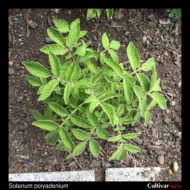 |
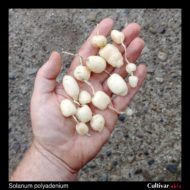 |
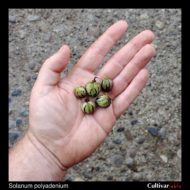 |
|
Cultivation
I have found this species difficult to germinate using the standard conditions for S. tuberosum. The USDA potato genebank has observed that some accessions of this species are dependent upon GA3 for germination (Bamberg 1999).
Towill (1983) found that seeds of this species stored at 1 to 3 degrees C germinated at 100% after 16 years and 72% after 24 years.
Breeding
Crosses with S. tuberosum
Watanabe (1991) found that 6.2% of varieties of this species produced 2n pollen, which would be effectively tetraploid and 4EBN.
| Female | Male | Berry Set |
Seed Set | Ploidy | Germ | Source |
|---|---|---|---|---|---|---|
| S. tuberosum | S. polyadenium | Minimal | None | Jackson (1999) | ||
| S. polyadenium | S. tuberosum | None | None | Jackson (1999) | ||
| S. pinnatisectum | S. polyadenium | Yes | Yes | Swaminathan (1955) | ||
| S. polyadenium | S. jamesii |
Yes | Yes | Yes | Graham (1961) |
Crosses with other species
Jackson (1999) found 1-2% 2n pollen for varieties of this species.
| Female | Male | Berry Set |
Seed Set | Ploidy | Germ | Source |
|---|---|---|---|---|---|---|
